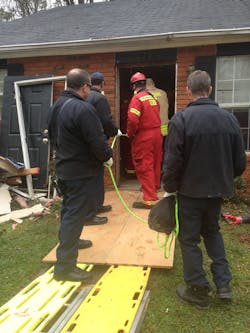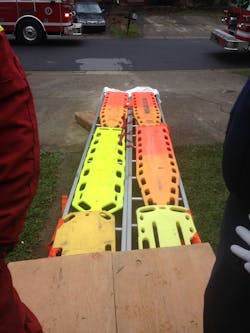Editor’s Note: Firehouse is excited to announce a new regularly published feature focused on Fire-based EMS. Watch for additional Fire-based EMS features in the July and October issues.
You are at the station, sitting at the computer to work on a pre-fire plan. The alarm tones drop and are followed by, “Engine 1, respond to 1234 Main Street on a lift assist. Ambulance is requesting you to respond for assistance. Non-emergency response.” As you make your way to the apparatus bay, the question goes through your head, “Why do we always have to help them lift a stretcher?”
You open the mobile data terminal to mark responding and see the call information. Under the “comments” tab, it reads, “ambulance on scene requesting assistance with a large patient. Patient is 700 pounds.” Now you can see that you are not just going to “help lift a stretcher.” This seemingly routine call is no longer what you expected. In fact, it has transformed into a true life-threatening emergency. It is a call that will most likely stretch your knowledge and abilities regarding both EMS and technical rescue. Make no mistake, a life truly hangs in the balance.
This was the exact call one of my units received. One engine, truck, ALS rescue, two ambulances, two heavy squads, an EMS supervisor and one battalion chief later, the patient was removed from his residence. The extrication necessitated the removal of approximately 6 feet of interior wall, the placement of shoring and the removal of the front door, including the frame. A ramp was constructed with roof ladders side-by-side and plastic backboards secured to the ladders to facilitate sliding the patient up onto the floor of the ambulance.
The patient was ultimately taken to a local hospital where he had to be transferred to two different beds. The first bed was a bariatric bed that indicated that the load was over capacity. The patient was then transferred to an older, more solid-state gurney. Based on the capacity of the bariatric bed, the hospital estimated the patient’s weight to be over 800 pounds.
To assist the ambulance crews and the hospital staff, we sent three units to the receiving facility to assist with moving the patient. After moving the patient to the final gurney, his respiratory distress markedly increased. He repeatedly refused the respiratory therapist’s recommendation that he be put on a ventilator. He subsequently went into arrest and was unable to be resuscitated.
Additionally, during the operation, one of the firefighters on scene lifting the patient suffered a disk injury, requiring extensive treatment—an injury that will be with him for his entire career.
Unfortunately, calls involving bariatric patients are not as uncommon as you may believe. These patients present a host of issues for which we must account:
- Patient’s health condition for which we have been called to the scene
- Health complications secondary to the extreme obesity
- General state of mind and dignity of the patient
- Health hazards to the responders as they attempt to lift and move this patient
- Resources needed to move the patient
- Technical and building construction knowledge needed to alter building components to remove the patient
- Knowledge and understanding of the capacities of your equipment and how to utilize them safely
Failure to carefully consider any of these aspects can have a catastrophic effect that could end up in injury or death to the patient and/or responders. Additionally, it may open you and your department to civil liabilities.
Psychological considerations
Let’s take a closer look at the psychology and pathophysiology of this population of patients. It is easy and convenient to relegate them to someone who just “lacks self-control”—that if they would just order small fries instead of extra-large and “hit” the gym, they would not have these issues. The simple fact is that is an uninformed and superficial understanding of what is really going on.
Many years ago, I was talking with a former EMT student of mine turned physician’s assistant. He was working in a gastrointestinal (GI) practice that performed bariatric surgeries. I asked him, “Aren’t you just helping those without self-control continue with their lifestyle?” In that conversation, he helped me understand how ignorant I was about the psychological complexity of this issue. These patients can no more control the behavior that perpetuates this destructive cycle than can the anorexic or bulimic patient. This is not a simple lack of will, but a wholly destructive psychologic problem that many of us cannot understand. Unfortunately, like many of the things we cannot understand, we tend to put them in terms that are convenient to us, but may be entirely predicated on false or misinformed logic.
For example, in the 1980s, a doctor in California, Dr. Vincent Filetti, discovered a link between sexual abuse and patients who dropped out of his weight loss study. He discovered this completely by accident. He was actually trying to figure out why study participants would lose a tremendous amount of weight, and then drop out of the program only to gain it all back. He interviewed 286 study dropouts and uncovered that the vast majority of them had a history of being sexually abused(1). At least circumstantially, it seemed to link their unconscious desire to be overweight to their past as an abuse victim. As one woman put it, “… Overweight is overlooked, and that’s the way I need to be.”1 It was a defense mechanism to being sexually abused again.
This is not to say that every morbidly obese patient has the same history. I only use this example to show that there are quite often severe and devastating personal histories and experiences that contributed to the patients’ inability to control their weight. It is the reason we need to be considerate and professional on these calls, as we do not want to further victimize someone who has been tragically abused in the past.
Medical considerations
Medically, the extremely obese patient is very fragile. As their weight increases, there are anatomic and physiologic conditions that get worse. For example, if you look at a cross-section of the heart, in a non-bariatric patient (or even one with cardiovascular disease), the myocardium (the muscle portion of the heart) will most likely look just like, well, a muscle. There won’t be any visible distinction with regard to the appearance of the muscle fibers. In fact, with the cardiovascularly diseased patient, the problem is generally inside the vessels.
With the morbidly obese patient, the adipose tissues develop through the myocardium. There are visible fatty tissue lines that run through the muscular tissue. The appearance is similar to how you would see piece of meat in the deli marbled with fat. This interferes with cardiac output and makes it more difficult for the patient to respond to changing exertional demands.
Additionally, pressure on the diaphragm and weight on the chest make breathing a difficult process under the best circumstances. The patients are generally more comfortable in the inclined position. They may even be most comfortable on their sides. Deviations from the “comfortable” positions during extrication (i.e., lying the patient flat) can have life-threatening repercussions. It can be a deadly cycle of difficulty in breathing contributing to increased breathing rates. The patient's respiratory muscles increase their work which leads to a greater oxygen need. The rate increase can be difficult to maintain due to the weight of the patient. The heart increases to compensate, but the patient cannot tolerate the increase well, and it increases their breathing difficulty in a physiological and psychological way. This cycle perpetuates until an arrhythmia occurs secondary to the increased need for oxygen. If this patient arrests in the field, CPR, airway interventions, IV/IO access or other interventions are exponentially more difficult or ineffective. If the patient arrests while being transported on the floor of the ambulance, CPR may not even be possible due to space constraints or the ambulance and the inability for the rescuer to position themselves safely to perform the rescue procedures.
Moving the patient
So how do we effectively and safely move this patient? This requires a significant understanding of the physics involved, equipment limitations and adaptability of tactics to ensure safety for all. Ideally, extra thought and effort put into how to move the patient will probably be the most important means of mitigating the possibility of patient distress and death. I can say unequivocally that moving these patients will challenge your patience, resources and skills in unprecedented ways. The risks to the patient and rescuers are directly proportional to the size of the patient. A 400-pound patient will, without some other compounding medical issue, not have the same risks as does the 800-pound patient. The larger the patient, the more complicated the issue becomes.
The size of the patient has a direct impact on the resources you will need to safely and effectively mitigate the situation. You may have to construct systems like the ones we used on the aforementioned scene. Understanding the limits of your equipment and developing ancillary systems to overcome those limitations is critical. For example, if you are using a ladder to create a ramp on which to slide the patient, you need to know the limitations of the ladders.
We can easily exceed our safety margins. How do you adapt? You must support your ladder ramp. This can easily be accomplished by supporting the rails with cribbing and wedges, or just large wedges. A simple modification can solve the problem. Conversely, if we choose to “roll the dice” and use the ladders outside our safety margins due to lack of resources or patience, the result could literally kill the patient.
Let’s say you are constructing a ramp to the floor of the ambulance. If the ladder fails or the patient falls off the side, the forces to the patient can be mathematically calculated. In technical rescue, we deal in fall factors with relation to rope and height advantage systems. We can correlate those same principles to a patient falling and striking the ground. We know the greater the mass, the greater the impact force, and the force is increased by a factor of the height of the fall. If a rescuer is standing next to the patient and the patient falls into their knee, the injury could be career altering.
Many of these situations will involve the use of rope and rope systems. Knowing the limitations and how to adapt them to the situation is key. If you don’t have this knowledge, you are putting the patient and your crew at risk. You may be tempted to use a rope and ladder system for height advantage to move the patient. If you don’t have an intimate understanding of forces applied to the rope and equipment, you are asking for trouble. Remember, many of our rope systems are designed to support a two-person load of 600 pounds. In this scenario, the patient alone will exceed this. If the patient is above grade level in the structure, to say you have a difficult scenario doesn’t scratch the surface.
The easy solutions may involve motorized systems and equipment that use cable systems with much greater capacities. If you plan on using cranes, aerials with cables, wreckers or winches, you must carefully plan out how you will use them. In most technical rescue situations, rope and manual haul systems are preferred. This is so you don’t inadvertently overtax equipment or injure a patient/rescuer.
When you use the manual haul systems, the haul team has a high level of sensitivity to resistance. It makes it more likely that if the patient or rescuer gets hung up, this will be transmitted to the haul team. With attention to increasing resistance, the team can stop and see what remedy needs to be applied. Conversely, the operator of a winch will not be able to sense any increase in resistance in the system. If the patient or rescuer get hung up on something or part of the system binds on something, the winch will pull until something fails. The results can be catastrophic.
If you are going to use mechanized systems, you must have safeguards in place to ensure this cannot happen. As you can see, this is where the patience and knowledge come together to create a favorable outcome. In many of these situations, the patient is not in need of emergent removal, but more deliberate removal. Time is not an issue; your patience is the complicating factor.
So how do we effectively handle these situations? We need to ask ourselves the following questions?
- What is the condition of my patient?
- Where is my patient? Grade level? Upper floor? If upper floor, is there a building system (i.e., elevator) that can be used within its parameters?
- Will I have to alter the structure to facilitate removal? If so, will it affect the structural stability of the building? How do I compensate for that (i.e., shoring)?
- Will I be able to maintain the patient’s current position throughout the extrication? If not, is there something I can do to mitigate the distress (i.e., supplemental oxygen, CPAP or other respiratory aids)?
- How will I transport the patient from the scene?
- How will I get the patient into the transport vehicle and out of the vehicle once at the destination?
- What equipment do I need that I don’t have here right now?
Answering all these questions before you start the process is essential in a successful operation. Repositioning the patient and partially completing the move can have severe consequences on the patient’s level of stress or health. Don’t start moving the patient unless you are sure you can complete the process in one continuous operation. The work you put into planning and constructing your system will pay dividends to the health of the patient and rescuers alike. Imagine starting an operation that was poorly conceived or implemented. The crew needs to halt, causing the patient distress level to increase to the point of arrest. Now you will have increased your workload (moving and performing CPR), and decreased the likelihood of the safety of your patient and rescuers alike.
In sum
With our ever-expanding roles, we need to make sure we are carefully applying and adapting our skills to the ever-evolving situations we find ourselves in. The proliferation of bariatric patients in our increasing response profile is an example of this. This seemingly benign “service” call has the potential to be life-threatening for the patient if we don’t consider it carefully. Additionally, the injury risk to responders cannot be overestimated. A bulging disk in the back for a young firefighter can be career-ending and life-altering. Don’t let a lack of patience or planning put the patient, your firefighters or you in a losing situation.
Remember, in most instances, we control the variables. We must take care of the patient emotionally and physically while providing for our own crews’ safety. We must be very deliberate and intentional in how we handle these calls. Even though these types of responses may seem benign, there are true life-and-death implications in these situations. The best advice is in the old axiom, “failing to plan is planning to fail.”
Reference
Stevens, J. “The Adverse Childhood Experiences Study—the largest, most important public health study you never heard of—began in an obesity clinic.” Aces Too High News. Oct. 3, 2012. https://tinyurl.com/ACES-clinic.
Christopher Sobieski
Christopher Sobieski serves as a battalion chief with Cobb County, GA, Fire & Emergency Services. He is a 32-year veteran of the fire service, serving 29 years in Cobb County. His career started as a volunteer in the Northern Virginia/Washington, DC, area. As a battalion chief, he works in Cobb’s 1st Battalion, which covers South Cobb County. Additionally, he is a paramedic and served as a paramedic instructor for 20 years. He served on Cobb’s Technical Rescue Team as well as being a part of the Georgia Search and Rescue TF-4. He also served as the executive officer for Cobb’s Director of Public Safety.








